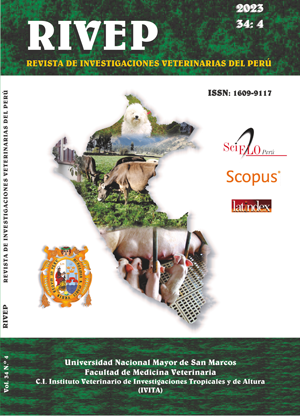Microplastics in Emerita analoga (Crustacea: Hippidae) and in sediments on eight sandy beaches of Lima, Peru
DOI:
https://doi.org/10.15381/rivep.v34i4.25968Keywords:
bioindicator, marine pollution, Emerita analoga, microplastic particles, sandy beachesAbstract
Microplastics (MP) have been recorded in marine ecosystems around the world; however, little is known about the temporal and spatial variation of PM on marine beaches in Peru. In this work, PM were evaluated in Emerita analoga (Crustacea: Hippidae) and in the sediments of eight sandy beaches, north and south of the city of Lima, in two seasons. Thirty individuals of E. analoga and sediment samples were collected from each of the eight beaches for each season (winter and summer). The PM were extracted, counted and characterized. An abundance of 0.02 ± 0.13 to 1.82 ± 6.31 PM items/individual was observed in E. analoga and in the sediments they varied from 41 ± 31.07 to 5353 ± 4013 PM items/kg. Fragments were the predominant type in the sediments, whereas fibres were the predominant type in E. analoga. Transparent was the most frequent color. Particle sizes in the sediment ranged mainly between 1000 and 3000 µm, and in E. analoga less than 1000 µm. It can be affirmed that spatio-temporal variation plays a more important role in the dynamics of PM in sediments compared to E. analoga. The abundance of PM in the beach sediment was not related to the proportion of individuals in E. analoga that ingested them, nor with the amount ingested.
Downloads
Downloads
Published
Issue
Section
License
Copyright (c) 2023 Juan García, José Iannacone, Lorena Alvariño

This work is licensed under a Creative Commons Attribution 4.0 International License.
AUTHORS RETAIN THEIR RIGHTS:
a. Authors retain their trade mark rights and patent, and also on any process or procedure described in the article.
b. Authors retain their right to share, copy, distribute, perform and publicly communicate their article (eg, to place their article in an institutional repository or publish it in a book), with an acknowledgment of its initial publication in the Revista de Investigaciones Veterinarias del Perú (RIVEP).
c. Authors retain theirs right to make a subsequent publication of their work, to use the article or any part thereof (eg a compilation of his papers, lecture notes, thesis, or a book), always indicating the source of publication (the originator of the work, journal, volume, number and date).










